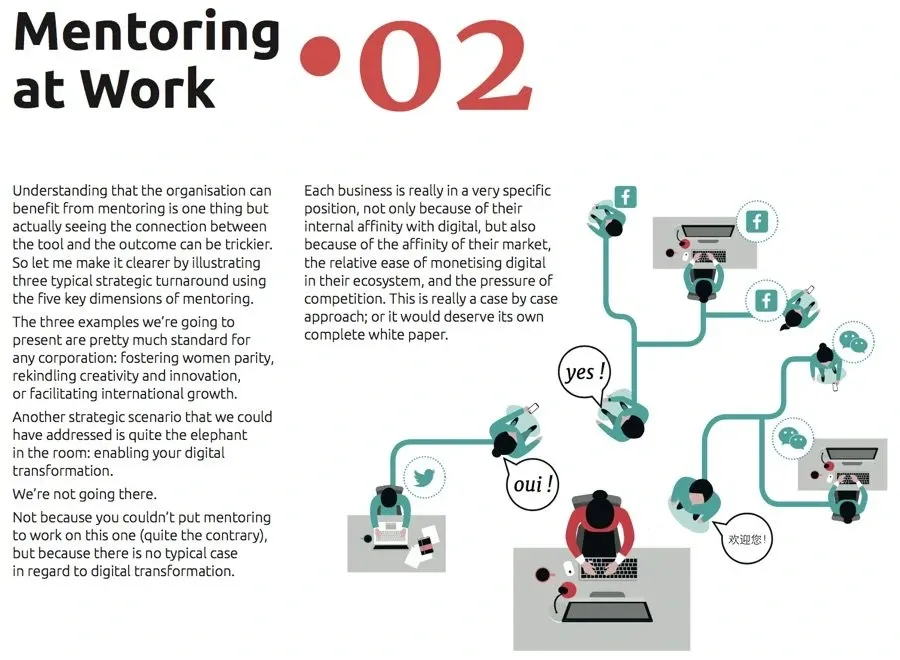Mentoring for innovation culture

To foster innovation in large corporations, several key and « difficult to get » ingredients need to be gathered: creativity, market awareness and risk mindset whilst being reassuring to existing customers with a solid, efficient structure.

Mentoring for innovation not only requires being great at what you are doing but also having employees with the capacity to adapt their thinking and mindset in line with society. With the evolution of demographics, people’s needs and technologies, corporations need to embrace hybridisation and be willing to open to new markets, be aware of unexpected competitors and realise that what was true decades ago about markets is no longer valid.
It is the confrontation with the outside — often unrelated — world that can stimulate the ideation process. Innovation emerges out of a confrontation with the unexpected. This is why so many creativity techniques are based upon divergence and shifted perspectives.
To generate this necessary open-mindedness, a solid mentoring programme will usually rely on two key tools linked to the « ➌ Height » and « ➍ Space » dimensions:
- A closed internal network for mentees in key strategic activities, with mentors at key positions in different parts of the organisational chart (linking manufacturing and marketing, for example);
- An open external network with successful entrepreneurs as mentors, preferably not in the same market as the company.
And within these two networks of mentors, the cultural mix will have to be adjusted with great care. Consider in that regard the « ➋ Horizon » dimension of the programme, and make sure that depending on your industry, market need and current culture, you create an adequate mix of :
- Generations: allowing mentors to learn about new generations’ issues, new trends in usage and technologies and mentees to learn about organisational culture and best practices;
- Cultures: be it geographical, ethnic or organisational;
- Activities: cross-departments, cross-functions, and cross-markets.
You need to realise that by nature, innovation will appear in unexpected ways, which is the point of building such cultural mixes. Recently, examples of surprising pay-offs that we had while setting up mentoring programmes were:
- Cross-corporations mentoring with mentees from an IT company developing mobile software for customers in payment systems stimulated mentors in the automotive industry to prototype new dashboard apps.
- Mentoring between the extremities of a medical value chain generated direct benefits for the patient by enhancing up-the-chain employees’ understanding of surgeons’ needs and behaviours and widening down-the-chain employees’ perspectives on potential product externalities while used in an operating room.
- Mentoring between similar activities in different countries for a retail multinational allowed for more inspiration and insights into future businesses in Europe, based on recent Japanese trends in mobile social networks.
- Intrapreneurs from a corporation in defence systems paired up as mentees with experienced entrepreneurs, developing several new prototypes in three months, down from one year.
With mentors and mentees gaining confidence in playing with new ideas, exchanging with less formality and more diversity, you’ll alleviate the constant pressure of managers to justify everything as a sound business decision.
And that’s good: if you can fully back up every idea with a business plan, they’re not going to be very disruptive, and you’ve been thinking about them for probably too long.
Rapidly, you’ll also see that you are building on « ➊ Speed » and « ➎ Resilience » at the corporate level.
This last example of intrapreneurship is, by the way, a much more secure approach to the fabled « new businesses incubator » initiative that has popped into many multinationals these last years. Instead of trying to pool new ideas from your employees through internal contests, selecting half a dozen a year, and trying to nurture them in a special room with post-its, bean bags and 3D printers… build a mentoring network; it works wonders.





